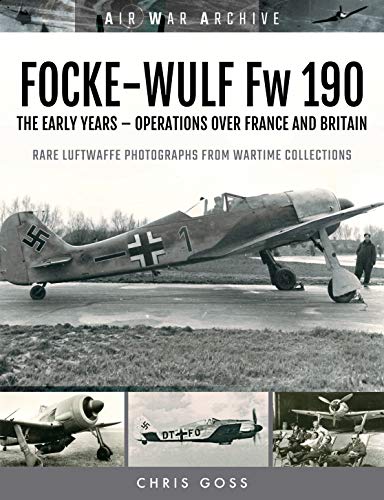Items related to FOCKE-WULF Fw 190: The Early Years - Operations Over...
FOCKE-WULF Fw 190: The Early Years - Operations Over France and Britain (Air War Archive) - Softcover

"synopsis" may belong to another edition of this title.
"About this title" may belong to another edition of this title.
- PublisherFrontline Books
- Publication date2019
- ISBN 10 1473899567
- ISBN 13 9781473899568
- BindingPaperback
- Number of pages176
- Rating
Buy New
Learn more about this copy
Shipping:
£ 4.50
From United Kingdom to U.S.A.
Top Search Results from the AbeBooks Marketplace
Focke-Wulf Fw 190
Book Description paperback. Condition: New. Seller Inventory # 9781473899568
Focke-Wulf Fw 190 : The Early Years Operations in the West
Book Description Condition: New. Seller Inventory # 33759412-n
FOCKE-WULF Fw 190
Book Description PAP. Condition: New. New Book. Shipped from UK. Established seller since 2000. Seller Inventory # GB-9781473899568
FOCKE-WULF Fw 190 (Paperback)
Book Description Paperback. Condition: new. Paperback. The Focke-Wulf Fw 190 was widely regarded as the Luftwaffe's finest fighter. It first saw service in France in August 1941, immediately proving itself at least the equal of the then latest Spitfire variant, the Mk.V. There were a number of characteristics which contributed to the Fw 190's success. The first of these was that it had been designed from the outset to be a weapons platform, rather than an aircraft to which weapons were added, as was the case with previous fighters. This meant that it could carry a wide range of armament in the form of various combinations of bomb racks, cannon pods and, later, unguided rockets. It was also built to withstand heavy punishment, with the extensive use of electrically-powered equipment instead of the hydraulic systems which, used by most aircraft manufacturers of the time, were more susceptible to failure if damaged by gunfire. The relatively small diameters of electrical wires were much less likely to be hit by gunfire than larger hydraulic pipes. In this illuminating study of the early service of the Fw 190, Chris Goss has assembled a unique collection of photographs illustrating the wide use of this highly versatile aircraft. AUTHOR: Having retired from the RAF with the rank of Wing Commander, Chris Goss is a regular and highly respected contributor to major aviation publications in the UK, France and Germany, as well the author of twenty-nine critically-acclaimed books covering the air war between 1939 and 1945. Chris completed an MA with Merit in War Studies in 2001. 190 illustrations An insight into the aircraft that is widely regarded as the Luftwaffe's finest fighter. Shipping may be from multiple locations in the US or from the UK, depending on stock availability. Seller Inventory # 9781473899568
FOCKE-WULF Fw 190: The Early Years - Operations Over France and Britain (Air War Archive)
Book Description Paperback. Condition: New. BRAND NEW ** SUPER FAST SHIPPING FROM UK WAREHOUSE ** 30 DAY MONEY BACK GUARANTEE. Seller Inventory # 9781473899568-GDR
Focke-wulf 190: The Early Years - Operations over France and Britain
Book Description Paperback. Condition: Brand New. 172 pages. 10.00x7.75x0.50 inches. In Stock. Seller Inventory # __1473899567
FOCKE-WULF Fw 190: The Early Years - Operations Over France and Britain
Book Description Paperback / softback. Condition: New. New copy - Usually dispatched within 4 working days. Seller Inventory # B9781473899568
FOCKE-WULF Fw 190: The Early Years - Operations Over France and Britain
Book Description Condition: New. 2019. Paperback. . . . . . Seller Inventory # V9781473899568
Focke-Wulf Fw 190: The Early Years - Operations Over France and Britain (Air War Archive)
Book Description Condition: new. Seller Inventory # 0S4WZUS3EG
Focke-Wulf Fw 190: The Early Years - Operations Over France and Britain (Air War Archive)
Book Description Condition: new. Seller Inventory # FrontCover1473899567

